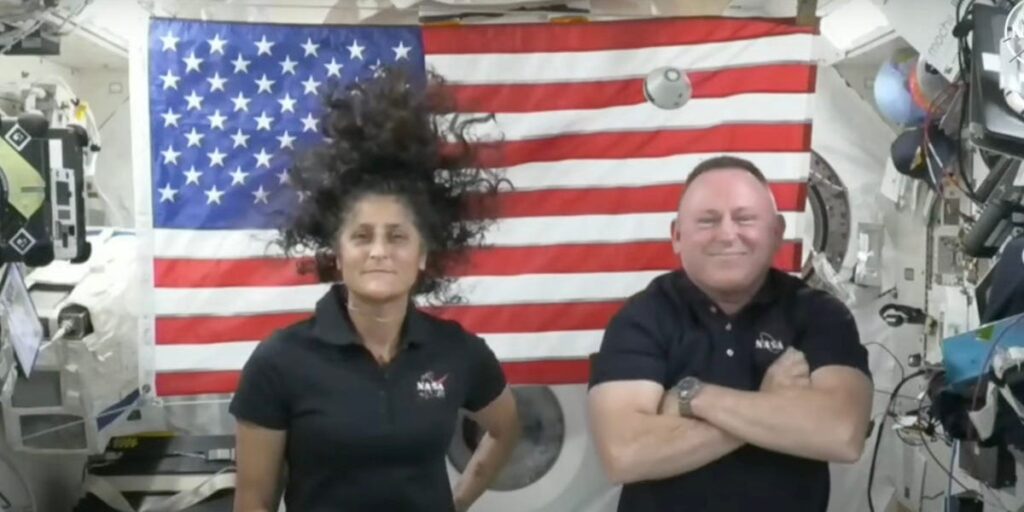After weeks of rigorous deliberation and serious safety concerns, NASA has decided to entrust the lives of two astronauts trapped on the International Space Station to SpaceX.
NASA Administrator Bill Nelson made the announcement at a news conference Saturday at the Johnson Space Center in Houston.
The two astronauts, Suni Williams and Butch Wilmore, have been aboard the ISS for 11 weeks. Their mission was originally scheduled to last eight days.
The ordeal began when Starliner was en route to the International Space Station in June when five of its 28 reaction control system thrusters failed, and the spacecraft’s helium system was also leaking.
Mission controllers have been working ever since to solve problems and test the spacecraft, hoping that they, and no one else, can bring the astronauts home safely.
NASA leadership met internally early today to consider whether Williams and Wilmore could return safely to Earth aboard Boeing’s Starliner spacecraft, or whether they should rely on SpaceX’s Crew Dragon.
“I want you to know that Boeing has worked diligently with NASA to obtain the data necessary to make this decision,” Nelson said. “We look forward to further understanding the root cause and design improvements to ensure that Boeing Starliner can be a vital part of ensuring crew access to the ISS.”
Nelson said he had spoken with Boeing CEO Kelly Ortberg, who said the company would continue to work on the Starliner issues.
At a July press conference, NASA officials acknowledged that the option of relying on SpaceX to retrieve the astronauts remains open, but did not provide details.
NASA confirmed SpaceX’s backup plan this month, postponing the company’s next launch to September 24. The delay means Wilmore and Williams will return in a four-person spacecraft with a SpaceX crew in February, about eight months later than originally planned.
SpaceX’s plan is not without risks.
Wilmore and Williams arrived at the ISS wearing spacesuits that fit the Boeing Starliner, not the ones that fit the Crew Dragon spacecraft, which Fortune reports would have to travel to Earth without spacesuits, as the Crew Dragon spacecraft would not provide adequate protection.
Boeing’s Starliner spacecraft during NASA’s Boeing Crew Flight Test in June. Joe Raedle/Getty Images
It’s perhaps the biggest safety decision NASA has made in decades, as the Space Shuttle Columbia disaster, which killed seven astronauts, has been weighing on the minds of Starliner mission managers, many of whom were involved in the failed flight, Ars Technica reports.
“I’ve been really focused lately on the concept of combating institutional silence, and unfortunately, if you look at both Challenger and Columbia, you see instances where people had the right data and valid claims, but the environment just didn’t allow it,” Russ DeLoach, NASA’s director of Safety and Mission Assurance, said during an Aug. 14 briefing on the Starliner mission.
At the press conference, Nelson acknowledged that NASA had made mistakes in the past.
“Space flight involves risks,” he said, “even at the safest and most routine times. Test flights are inherently neither safe nor routine, so the decision to leave Butch and Suni behind on the International Space Station and return an uncrewed Boeing Starliner is a reflection of our commitment to safety.”
Elon Musk’s SpaceX Starbase in Boca Chica, Texas. CHANDAN KHANNA/Getty Images
NASA has spent $4.2 billion to develop Starliner. The contract is part of the agency’s Commercial Crew Program, an effort to give the NASA multiple options for U.S.-based human spaceflight instead of relying on Russia’s Soyuz spacecraft.
Starliner’s original mission was to prove it could safely transport astronauts to the International Space Station on a regular basis, and while the failure of this mission is a major blow to Boeing’s space business, NASA’s comments on Saturday seem to indicate it plans to continue working with the company.
Boeing and SpaceX have been working with NASA for a decade on developing their Starliner and Crew Dragon spacecraft, respectively.
NASA has always maintained that the program isn’t a contest or a race, but if it were, SpaceX would have won in a big way. As CEO Elon Musk pointed out before Williams and Wilmore’s launch, not only did the company complete its first crewed test flight four years ago, it also only ended up costing NASA $2.6 billion.
After years of delays, technical issues and rising costs, the crewed test flight was the final hurdle Boeing had to overcome before NASA could certify Starliner for crewed spaceflight.



